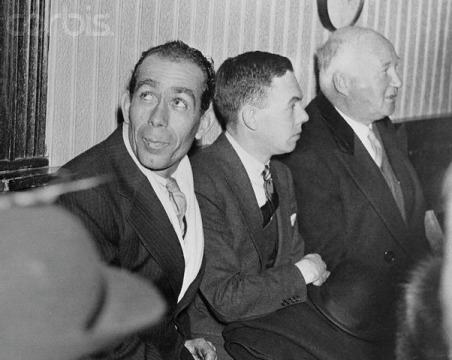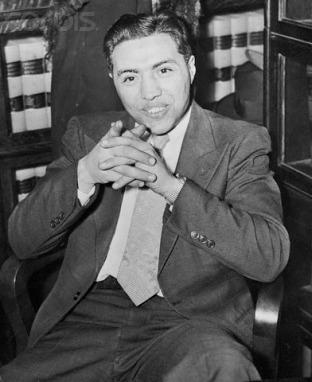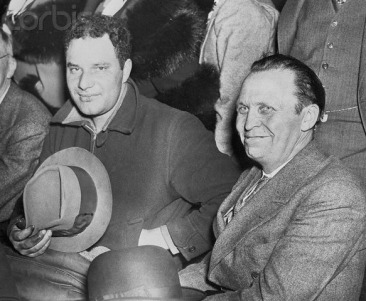Witnesses
AMANDUS HOCHMUTH was an eighty-four year-old man who loved to sit and watch an intersection near the Lindbergh home. He was fascinated by the amount of people who accidently drove into a ditch by the road from turning too fast. On March 1, 1932, before noon, Hochmuth said he noticed a dirty green Sedan driving from Hopewell at a fast speed. At the last minute, the driver applied the brakes and the car came to a halting stop in front of the ditch and stalled. As the driver attempted to restart the vehicle, Hochmuth claimed he saw a ladder in the car. Hochmuth said he never forgot the green Sedan nor the driver inside. The Defense Attorney, Ed Reilly, said that Hochmuth never saw Hauptmann until his photograph appeared in newspapers. It turned out that a state trooper had pointed Hauptmann out to Hochmuth prior to his identification. Hochmuth also had a bad memory, poor eyesight, and was once in an asylum. Hochmuth claimed Reilly spoke all lies, but when asked to describe the man he saw, Hochmuth said he had a red face. Hauptmann was pale.
Millard Whited
Original caption: To testify at Hauptman trial. Millard Whited, Lambertville, New Jersey, lumberman, who will testify that he saw the dependent in the vicinity of the Lindbergh home at Hopewell about the time of the kidnapping, is pictured (left), at the Hunterton County Court, Flemington, Jan. 21, where Bruno Richard Hauptmann is being tried for the kidnapping and murder of Charles A. Lindbergh, Jr.
IMAGE:© Bettmann/CORBIS
MILLARD WHITED owned a farmhouse near the Lindbergh home. He claimed that one night in the middle of February he saw a stranger standing on the side of the road that bordered the Lindbergh's estate. The stranger was a surprise to Whited, who rarely noticed anyone new in this isolated area. About a week later, according to Whited, he was driving from the Lindbergh estate using a back road. He was a mile and a half from the Lindbergh's land when he noticed the same strange man standing along the road. The man started to cross the road, stopped, and then stared in Whited's direction. Whited noticed that the man wore a gray felt hat and a gray suit, and was carrying an overcoat. Whited was known as a pathalogical liar. The defense produced three witnesses, William Whithead, George Leiz, and William Diehl, who claimed that no one ought to believe anything Whited said. The prosecution team discounted the witnesses, stating that all three men had past disputes with Whited and were merely trying to get revenge. Some, however, believe that Whited made up a story about seeing Hauptmann for financial gains. Whited denied seeing anything or anyone near the Hopewell house on March 1. After police revisited him with an offer to pay his meal and hotel expenses at the trial he then decided to identify Hauptmann. Whited was said to not be able to identify the two police officers who questioned him for fifteen minutes, yet he could swear that Hauptmann was the man he saw for a few seconds in a moving vehicle?
Witness Ben Lupica
Original caption: Ben Lupica, Princeton University student, who claims he saw a car in Feathered Lane, near the Lindbergh Hopewell, N.J., home, with a ladder tied to its side on the night of the kidnapping, is pictured at the Hunterdon County Courthouse, Flemington, New Jersey, Jan. 8, where he will testify for the State in its trial of Bruno Richard Hauptman, alleged Lindbergh child kidnapper.
IMAGE:© Bettmann/CORBIS
BEN LUPICA lived with his parents and attended Princeton Preparatory School. While he was driving home on March 1, he stopped at his family's mailbox. He got his mail, drove a little more down the road, and then stopped to read some of his mail. As he read his mail, he heard a car coming. He noticed the advancing car was a dark blue or black Dodge Sedan. He claimed it was made in 1928 or 1929 and had New Jersey plates. Lupica watched as the driver of the Dodge Sedan drove with fast speed, swerving to the wrong side of the road and almost driving into a cornfield. He said the driver was in his mid-thirties and had a thin, sharp-featured face. The man, Lupica claimed, wore a dark felt hat and a dark overcoat. Lupica started his vehicle and passed the stopped Dodge Sedan. As he drove past the car, he noticed a ladder was sitting inside.
Defense Witnesses to Hauptmann Original caption: Lou Harding, and August Von Henke, (right), important Defense witnesses, pictured at the Hunterdon county Courthouse, Flemington, New Jersey, Jan. 31st, when they submitted important testimony that strengthened the defense of Bruno Richard Hauptmann, alleged Lindbergh kidnapper. Harding, (left), who admitted to several conviction, testified that he saw two men, neither of them Hauptmann, in a car that contained a ladder similar to Theone used in the kidnapper, near the scene of the crime.
IMAGE:© Bettmann/CORBIS COLLECTIONBettmann
IMAGE:© Bettmann/CORBIS COLLECTIONBettmann
LOU HARDING said he saw a car in the area of the Hopewell house before the kidnaping, and the car had a ladder inside. He said that there were two men in the car. The automobile had stopped to ask for directions to the Lindbergh house. One must wonder why a kidnaper would ask for directions- isn't that a little odd?
HILDEGARDE ALEXANDER, a young female, said that in March of 1932, she saw Dr. Condon at a railroad station in the Bronx, talking to a telegraph operator in the waiting room. Alexander said that she saw a man watching Dr. Condon, a man who looked like Hauptmann. Many believed, however, that Alexander lied because she was in seek of fame. She wanted to be an actress so she lied to get her name in the spotlight.
by Ronelle Delmont
by Ronelle Delmont




